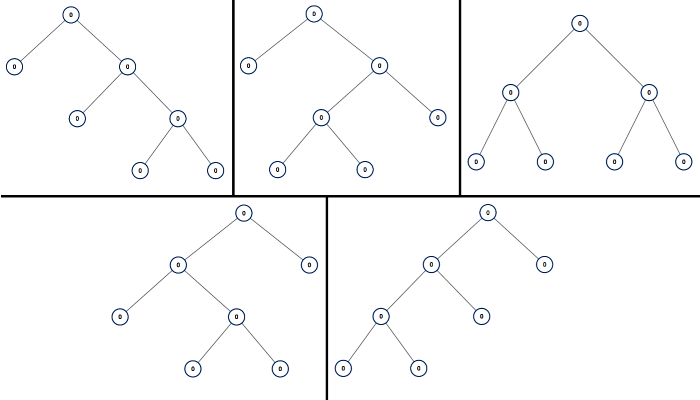Given an integer n, return a list of all possible full binary trees with n nodes. Each node of each tree in the answer must have Node.val == 0.
Each element of the answer is the root node of one possible tree. You may return the final list of trees in any order.
A full binary tree is a binary tree where each node has exactly 0 or 2 children.
Example 1:

Input: n = 7
Output: [[0,0,0,null,null,0,0,null,null,0,0],[0,0,0,null,null,0,0,0,0],[0,0,0,0,0,0,0],[0,0,0,0,0,null,null,null,null,0,0],[0,0,0,0,0,null,null,0,0]]
Example 2:
Input: n = 3
Output: [[0,0,0]]
Constraints:
- 1 <= n <= 20
这题着实费了点功夫去想, 一开始还是想着用递归加遍历的方式来做, 但是因为是要生成完全二叉树, 所以比较复杂。后来看着图,突然想到,其实完全二叉树就是一个根节点和左右两个完全二叉树的组合, 这样我们从只包含一个节点的二叉树开始推, 推到 n 个节点的二叉树的所有排列就可以了。这里要注意一点的是,只有 n 为奇数的时候才能生成完全二叉树。
use std::cell::RefCell;
use std::collections::HashMap;
use std::rc::Rc;
impl Solution {
fn clone(root: &Option<Rc<RefCell<TreeNode>>>) -> Option<Rc<RefCell<TreeNode>>> {
if let Some(node) = root {
let mut copy = TreeNode::new(node.borrow().val);
copy.left = Solution::clone(&node.borrow().left);
copy.right = Solution::clone(&node.borrow().right);
return Some(Rc::new(RefCell::new(copy)));
}
None
}
pub fn all_possible_fbt(n: i32) -> Vec<Option<Rc<RefCell<TreeNode>>>> {
if n % 2 == 0 {
return vec![];
}
let mut m: HashMap<i32, Vec<Option<Rc<RefCell<TreeNode>>>>> =
vec![(1, vec![Some(Rc::new(RefCell::new(TreeNode::new(0))))])]
.into_iter()
.collect();
for i in (3..21).step_by(2) {
if i > n {
break;
}
let mut nodes = Vec::new();
for l in (1..i).step_by(2) {
let lefts = m.get(&l).unwrap().clone();
let rights = m.get(&(i - 1 - l)).unwrap().clone();
for left in &lefts {
for right in &rights {
nodes.push(Some(Rc::new(RefCell::new(TreeNode {
val: 0,
left: Solution::clone(left),
right: Solution::clone(right),
}))));
}
}
}
m.insert(i, nodes);
}
m.get(&n).unwrap().clone()
}
}